Today we’re going to talk about my experiences with the Pioneer DDJ-SR controller.
The Pioneer DDJ-SR was my first exposure to something that resembles a “real” DJ set-up. I had pushed my borrowed DDJ-WeGo to the limit after about a year and had lined up my first live show.
I was two days away from playing the show with the WeGo but managed to snag a used DDJ-SR for a great deal on a local online classified.
I didn’t have much time to master it but I set off to learn how to use the damn thing before my first show. It didn’t take long for me to get used to the layout because everything was easily oriented on each side of the controller. So here’s what I experienced with it in this Pioneer DDJ-SR Review.
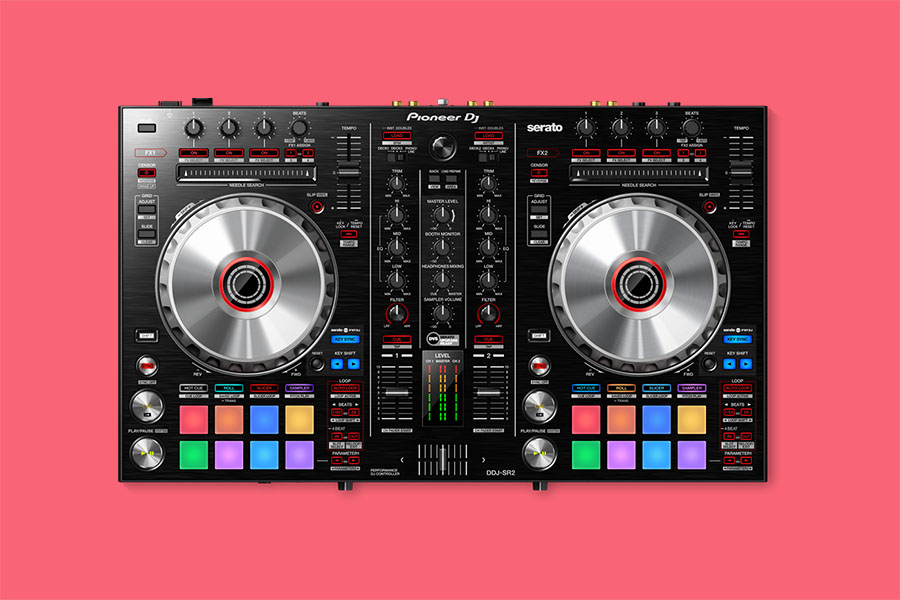
Note: The Pioneer DDJ-SR has been discontinued. If you’re looking for awesome alternatives, check out our roundup of the top 12 best DJ controllers on the market.
Backstory Continued…
A funny thing that happened to me at that show. I had just plugged in my brand new (to me) DDJ-SR in to the speakers and was playing on proper speakers for the first time. I was stoked for people to arrive and start vibing with me.
The DJ who was to go on after me (also the friend who landed me the gig) shows up with a brand new DDJ-SR2.
Took a little wind out of my sails but when he mentioned how it cost him about three times what I had paid, I was quickly satisfied with my purchase again.
The more familiar I got with different controllers, the more I appreciated the workhorse quality that the DDJ-SR offers. It doesn’t light up in a fancy way but it does anything you need at a great price.
I played with this DDJ-SR a lot throughout my first year of DJing local clubs and it was awesome. It is a great intermediate course in the world of DJ controllers. It has great value and has some features that I would even rank as more effective than the flagship CDJs that Pioneer offers.
Last summer I was lucky enough to get to play a few sets on a couple of different high-end Pioneer controllers, such as the DDJ-SX2 and DDJ-SZ. Having to jump right in and play live with a new controller coming from the SR was fairly seamless.
If you’re looking for a professional Serato controller but can’t afford the DDJ-SX2 or DDJ-SZ, you should definitely consider this controller – the DDJ-SR.
DDJ-SR Review: Features
The most obvious thing about most DJ controllers are the platters. The ones on the DDJ-SR are a great place to start to get used to the way that large platters feel. There aren’t any frills like flashing lights or displays near them – but for me, that wasn’t a big deal. After all, this controller is pretty cheap!
Quick nudge of the edge to bring it into beat, or fairly decent sized wheels to scratch or seek through a track.
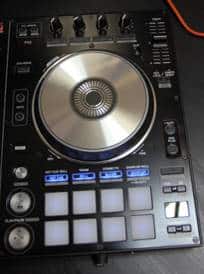
Those familiar with the DDJ-SR2, DDJ-SX and DDJ-SZ will notice that the DDJ-SR does not have a NEEDLE SEARCH strip above the jogwheel. I actually prefer that it is left off.
I can’t count how many times I’ve grazed them while trying to use the FX units nearby and have the track skip abruptly to a random spot. Very frustrating as you and everyone else tries to figure out what the heck just happened.
One thing I love about the DDJ-SR are the FX units on the top of each deck. You have so much flexibility with the FX channels you can really get creative and start to experiment with what happens when you stack multiple FX on top of each other. I always try to simplify my computer display and was able to get used to the feel of the BEATS knob fairly quickly. Eventually I didn’t have to display the FX panel window in Serato and crowd my screen to know where I was in BEATS.
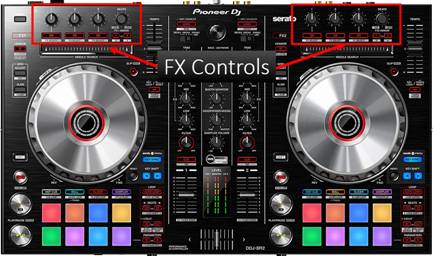
I usually ran an identical FX set-up on both sides but I didn’t really use the FX to the most potential, being a little newer to it all and focusing more on a smooth mix than too much experimentation with FX.
But if you’re a little more advanced, you can get a lot more potential out of this hardware. You can have a total of 6 unique effects if you want and engage them to any of the 4 Decks.
A great feature is to use the SHIFT button to engage FX SELECT, which means you can scroll through, find and assign any of the FX you have without having to touch your laptop at all.
Some of the guys who taught me how to DJ hadn’t even realized that you could do this, so you’re not limited by what effects you can use.
Similarly, the track selector knob at the top in the middle of the board is so easy to use in conjunction with the LOAD buttons that I rarely ever touched my laptop during an entire set. I run with a pretty haggard laptop so I figure minimal interaction with it is ideal.
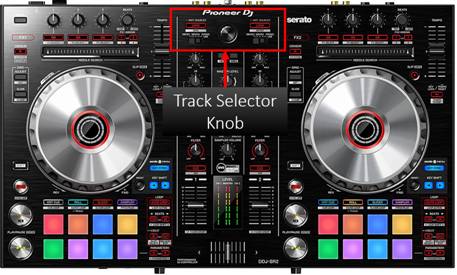
I also loved the way the LOOP function controls are laid out. Having recently had more exposure to CDJs, I am baffled why the looping function is more intuitive and easier to use on controllers like the DDJ-SR and DDJ-SX series than they are on the top-of-the-line players that Pioneer offers.
It is extremely easy to snap on a nice clean loop and then manipulate the length of the loop to crank up the energy or drop into something a little deeper.
Note that the loop size controls can also be used to change which ROLL timing you are using based on which of the pads you press.
While limited to only a HPF/LPF on what one might call the “Colour FX” knob (under the EQ controls) it does nicely mimic the higher end DJM mixers by Pioneer and what you might find at a club setup. This is a nice introduction to those DJM mixers, because you get to use the most popular Colour Effect though not all 6.
The knob itself doesn’t appear to be too different than the knobs for the EQ, but it is enough to easily feel. You won’t need to always look at your hands to know the difference between the Bass control and the one for the Filter.
All of the knobs snap into the 12 o’clock position very nicely and the faders are smooth and solid as well. Like I keep saying about this thing, it is sturdy.
An underrated feature of this controller is that it only requires the power from USB, you do not need an external power supply to power the board. This makes the DDJ-SR surprisingly portable. If your laptop has a robust battery you could go even go completely wireless!
Like I mentioned earlier, my laptop’s capabilities are pretty embarrassing but I manage to run Serato and the DDJ-SR without issue every time.
The headphone volume was great, too great sometimes. More than once I’d hop on the decks after a friend had spun for a while and blast my ears out when trying to cue up my first track. The DDJ-SR offers both sizes for your headphones as well.
I experimented a lot with having colour coded cue points to tell me valuable information about each song I played. While those colour codes weren’t displayed on the controller itself (like the DDJ-SR2 does) it was very useful to have 8 possible cue points to use.
They will light up a bright blue if they have an assigned cue point and will be a duller blue if still empty. If you want to make a cue point on the fly just press on one of the empty pads and it will store that cue point in Serato for later use.
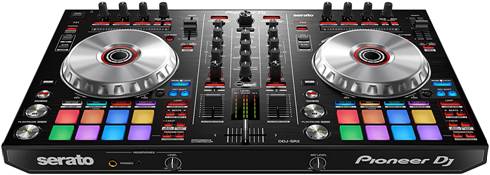
SLIP mode is really fun to play around with in tandem with the ROLL function, I used it sparingly while playing out but it was immensely fun to experiment with. Basically it keeps track of where the track should be before you started manipulating the playback.
Either through scratching or creative uses of the ROLL feature you might be off time, SLIP puts you back there automatically to not disturb the beat! You can see how powerful this can be, especially when you add other things in like INST DOUBLES.
I often like to incorporate some of my own samples and sound files in to my sets to “brand” them in a specific way. It’s a fun way to introduce myself, or to play certain hits and shots that will tie in to a certain tone or theme.
The Sampler is easy to control with the 8 Hot Cue Pads, and you can cycle through 4 different banks of 8 pre-loaded samples. The volume for the Sampler is controlled by a large knob in the middle of the board.
Changing between a 2 deck and 4 deck set-up is kind of clunky to use. So much so that I never really used it in live settings due to the unpredictability of what EQs and Fader level would be attached to it. You have to kind “reset” each element to be able to know where it actually is.
I would quickly slide the Fader up and down as well as twist each knob through all positions to make sure the last settings were cleared. Not a big deal but now when going back to the original deck you are expected to remember what the settings were on that channel. Not the end of the world and something you can definitely learn quickly enough if you require 3 or 4 decks.
Pioneer DDJ-SR Controller: Dimensions
The dimensions on this badboy are 21.8” x 2.57” x 12.56” and it weighs almost 10lbs, which is a bit heavy, but that’s the trade-off you have to make for something so solidly built. I live down the street from the club I usually played at and never had a problem carrying it under my arm and walking a few blocks with it, even when coming home late in the night after being paid in beers.

I’ve never used a case for my DDJ-SR, borrowed a sweatshirt once to carry it home in the rain but it shows no damage. I don’t beat up my gear but while I try to baby it, mistakes happen; this thing has stood up to weekly gigging no problem.
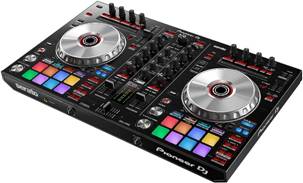
Pioneer DDJ-SR Controller: Inputs/Outputs
I wasn’t left wanting for much with this controller. It has pretty much all you need to start gigging and any of the more advanced features can be accessed through minor workarounds. By this I mean controlling 4 channels, firing samples, or slicing up your track to create live remixes.
Every time you play at a different club, if you have to set up your own gear, it’s anybody’s guess what you’re going to walk in to and be required to hook up to. The DDJ-SR has a lot of flexibility and can use either the 1/8” dual or 1/4” dual cables to connect.
There is an Auxiliary in port that I never actually used. I like to live dangerously I guess. I mentioned earlier the controller offers both size headphone jacks and my misadventures with the input for the microphone…
My Thoughts
I highly recommend this controller for practice and live sets. It is a great value and doesn’t feel like a cheap controller, it feels solid, smooth and well-built.
Depending on where you want to take DJing, this controller might be all you ever need. You can certainly play plenty of parties or weddings just fine with the DDJ-SR. For $500 on most used marketplaces, can’t really beat the value of this board.
